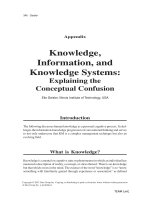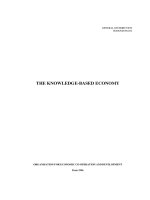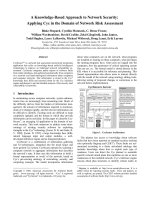Automated clinical decision model construction from knowledge based GLIF guideline models
Bạn đang xem bản rút gọn của tài liệu. Xem và tải ngay bản đầy đủ của tài liệu tại đây (664.85 KB, 101 trang )
AUTOMATED CLINICAL DECISION MODEL
CONSTRUCTION FROM KNOWLEDGE-BASED GLIF
GUIDELINE MODELS
ZHOU RUNRUN
(B.S. Tongji University)
A THESIS SUBMITTED
FOR THE DEGREE OF MASTER OF ENGINEERING
DEPARTMENT OF INDUSTRIAL & SYSTEMS ENGINEERING
NATIONAL UNIVERSITY OF SINGAPORE
2003
Acknowledgements
Acknowledgements
I would like to express my gratitude to:
Dr. Poh Kim Leng, my supervisor, for his guidance, encouragement, support and
generously imparting knowledge and expertise in the field. He introduced me to the
concepts of decision analysis and his solid thinking helped keep me on courses. His
understanding and patience during some difficult times are especially appreciated.
Dr. Leong Tze Yun, Xu Songsong, Lin Li, Zeng Yifeng, Zhu Ailing, and other people
in the Biomedical Decision Engineering Group, for their enthusiasm and advises.
Many of the interesting discussions with them have benefited this work.
All the members in System Modeling & Analysis Laboratory (SMAL), for their
friendship and help throughout the work.
My husband, Shen Lin, and family in China, for their love, care and support.
i
Table of Contents
Table of Contents
Acknowledgements ...................................................................................... i
Table of Contents........................................................................................ ii
Summary ..................................................................................................... v
List of Figures ............................................................................................ vi
List of Tables ............................................................................................viii
Chapter 1 Introduction .............................................................................. 1
1.1 Background ....................................................................................................... 1
1.1.1 Decision Analysis ...................................................................................... 1
1.1.1.1 Decision Problems .............................................................................. 1
1.1.1.2 Decision Analysis Process .................................................................. 2
1.1.2 Knowledge-Based Clinical Decision Making............................................ 4
1.1.3 Clinical Practice Guidelines....................................................................... 5
1.1.4 GLIF........................................................................................................... 6
1.1.5 Knowledge Acquisition and Protégé – 2000 ............................................. 7
1.2 Motivations & Objectives ................................................................................. 8
1.3 Overview of the Thesis ..................................................................................... 9
Chapter 2 Clinical Decision Model Construction.................................. 11
2.1 Introduction to Clinical DM............................................................................ 11
2.2 Decision Model Representations .................................................................... 12
2.2.1 Decision Trees ......................................................................................... 12
2.2.2 Influence Diagrams .................................................................................. 13
2.2.2.1 Nodes ................................................................................................ 14
2.2.2.2 Arcs ................................................................................................... 14
ii
Table of Contents
2.2.2.3 Evaluation ......................................................................................... 17
2.2.3 Bayesian Networks .................................................................................. 18
2.3 Ontological Features of Clinical DM.............................................................. 19
Chapter 3 The Knowledge-based CPG system...................................... 24
3.1 Knowledge Modeling Environment – Protégé-2000 ...................................... 24
3.1.1 Introduction to Protégé ............................................................................ 24
3.1.2 Protégé-2000 knowledge model .............................................................. 25
3.2 Medical ontology ............................................................................................ 27
3.2.1 Introduction to ontology .......................................................................... 27
3.2.2 Medical Ontology in GLIF ...................................................................... 27
3.3 Clinical Practice Guideline Model in GLIF.................................................... 31
3.3.1 Flowchart of GLIF ................................................................................... 32
3.3.2 Five categories of steps............................................................................ 33
3.3.3 Nesting ..................................................................................................... 37
Chapter 4 Methodology & System Architecture ................................... 39
4.1 Comparison of DMs and CPG representations ............................................... 39
4.2 Related work ................................................................................................... 40
4.3 CPG – to – DM Mapping................................................................................ 44
4.3.1 Assumptions............................................................................................. 44
4.3.2 The System Architecture.......................................................................... 45
4.3.2.1 The knowledge base.......................................................................... 46
4.3.2.2 Overview of the Decision Model Construction ................................ 47
4.3.3 Construction of the Decision Model ........................................................ 48
4.3.3.1 Decision model assumptions............................................................. 49
4.3.3.2 Mapping Model Structure ................................................................. 51
iii
Table of Contents
4.3.4 DM Refinement ....................................................................................... 55
4.3.4.1 Rationality of the DM ....................................................................... 55
4.3.4.2 Numerical Parameters....................................................................... 56
4.3.4.3 Level of representation ..................................................................... 57
Chapter 5 Case Study............................................................................... 59
5.1 Chronic Cough in Immunocompetent Adults ................................................. 59
5.1.1 Introduction to Chronic Cough ................................................................ 59
5.1.2 Problems in Chronic Cough Diagnosis and Treatment............................ 60
5.1.3 Notes on Chronic Cough Diagnosis and Treatment ................................ 60
5.2 Case description -- Cough Guideline model in GLIF..................................... 61
5.2.1 Purpose of the case study......................................................................... 61
5.2.2 Knowledge base used in the case study ................................................... 62
5.2.3 File format of the knowledge-based guideline model.............................. 62
5.2.3.1 Brief introduction on XML............................................................... 62
5.2.3.2 XML based Bayesian network format .............................................. 63
5.2.4 Chronic Cough Management DM Formulation....................................... 67
Chapter 6 Conclusion............................................................................... 76
6.1 Summary ......................................................................................................... 76
6.2 Contributions................................................................................................... 77
6.3 Limitations ...................................................................................................... 78
6.4 Future Work .................................................................................................... 78
6.4.1 Evaluation of the decision model............................................................. 78
6.4.2 Extend the current decision model to a dynamic DM.............................. 79
Reference ................................................................................................... 80
Appendix A Rough Decision Model in XMLID Format....................... 90
iv
Summary
Summary
Clinical decision analysis is a knowledge and labor intensive task. This thesis presents
a new approach to support automated construction of clinical decision models from a
knowledge base. The methodology aims to facilitate application of the decision
analysis paradigm in clinical domains. We make use of the knowledge-based Clinical
Practice Guideline (CPG) model in Guideline Interchange Format (GLIF) as the input
knowledge model. Together with the medical ontologies, which provide structured
data models and controlled vocabularies for referencing patient conditions and
therapies that are relevant to managing disease, it builds up the knowledge base for
clinical decision making.
We develop an algorithm to automatically build a rough decision model (RDM) from
the knowledge base described above. The RDM is a decision model that is not
complete in the structure, or parameters, or both. However, it gives a neat view of the
decision problem with the information extracted from the knowledge base. Rule-based
references are widely used in many guideline-based decision models. We incorporate
expected values computed from a decision-theoretic model to the hierarchical
representation framework. In addition, it greatly reduces the efforts needed for
constructing a decision model manually. With the rough model, the decision maker
could construct the complete decision model by modifying the RDM and filling in
additional information like probabilities and utilities.
v
List of Figures
List of Figures
Figure 1.1 Decision Analysis Cycle................................................................................ 2
Figure 1.2 The Proposed System Architecture ............................................................... 9
Figure 2.1 Decision Tree representation of the chronic cough treatment problem ...... 13
Figure 2.2 Relevance arc............................................................................................... 14
Figure 2.3 Influence arc ................................................................................................ 15
Figure 2.4 Information arc ............................................................................................ 15
Figure 2.5 Chronological arc ........................................................................................ 15
Figure 2.6 Value arc...................................................................................................... 16
Figure 2.7 ID representation of the chronic cough treatment problem......................... 16
Figure 2.8 Bayesian Network representation example ................................................. 19
Figure 2.9 Graphical depiction of interconnection model for disease & background .. 20
Figure 2.10 Representation of a typical clinical DM .................................................... 23
Figure 3.1 A concept hierarchy in Protégé editing environment. ................................. 26
Figure 3.2 Example of the step hierarchy and medical ontology support .................... 30
Figure 3.3 The GLIF Model, a top-level view of main GLIF classes .......................... 32
Figure 4.1 Schematic representation of ALCHEMIST’s architecture [Sanders 1998]. 41
Figure 4.2 Methodology of Zhu’s Work [2002] ........................................................... 42
Figure 4.3 Information known before decision is made ............................................... 44
Figure 4.4 Decision T is made before decision D......................................................... 45
Figure 4.5 Proposed system architecture ...................................................................... 45
Figure 4.6 Algorithm for the DM structure mapping ................................................... 52
vi
List of Figures
Figure 5.1 Screenshot of the knowledge model in xml format..................................... 65
Figure 5.2 DTD file for XMLID................................................................................... 66
Figure 5.3 The top-level cough management algorithm............................................... 68
Figure 5.4 The treatment of cough algorithm. .............................................................. 70
Figure 5.5 The nested representation of the decision node........................................... 72
Figure 5.6 The rough decision model ........................................................................... 74
Figure 5.7 Refined model ............................................................................................. 75
vii
List of Tables
List of Tables
Table 4.1 Comparison of DMs and CPG representations............................................. 40
Table 4.2 Attributes mapping from GLIF guideline model to DM .............................. 53
Table 4.3 Mapping from GLIF guideline model to DM ............................................... 58
Table 5.1 The mapping of Patient_State_Step to Chance Node ................................... 71
Table 5.2 The mapping of Action_Step to Decision Node ........................................... 72
Table 5.3 The mapping of Decision_Step (choice/case step) to Decision Node .......... 73
viii
Chapter 1 Introduction
Chapter 1
Introduction
1.1 Background
1.1.1 Decision Analysis
1.1.1.1 Decision Problems
Decisions are any action that a problem solver may take in structuring problems in
reasoning in allocating computational resources in displaying information or in
controlling some physical activity [Horvitz et. al., 1988]. Many real-world decisions
are hard to make due to the following reasons [Clemen 1996]:
•
complexity -- many possibilities and alternatives
•
uncertainty -- the future is not known for sure and available information is
vague or based on estimation.
•
multiple conflicting objectives -- many objectives are in conflict with each
other and values of many affected parties may be different or conflicting.
1
Chapter 1 Introduction
•
Diversity of opinions and perspectives -- different affect parties have different
perspective of the problems and different people may have different risk
attitude.
1.1.1.2 Decision Analysis Process
Probability provides a language for making statements about uncertainty and thus
makes explicit the notion of partial belief and incomplete information. Decision theory
extends probability theory, to allow us to make statements about what alternative
actions are and how alternative outcomes the results of actions are valued relative to
one another. Probability theory and the more encompassing decision theory provide
principles for rational inference and decision making under uncertainty.
Decision analysis is an engineering discipline that addresses the pragmatics of
applying decision theory to real-world problems. The Decision Analysis Process
[Holtzman 1989], which consists 4 iterative phases: decision problem formulation,
evaluation, appraisal and revision.
Evaluation
Confusion
Doubt
Uncertainty
Formulation
Deterministic
Analysis
Probabilistic
Analysis
Appraisal
Clarity of
Action
Revision
Figure 1.1 Decision Analysis Cycle
2
Chapter 1 Introduction
In the first phase -- formulation, the decision maker conceptualize and structure the
decision problem into a model which contains the alternatives (list of possible actions
that may be taken to address the problem), information (possible events and factors
that are relevant to the problem), and preference or value (desirability of different
consequences).
The second phase, evaluation, is to find out what is the recommended alternative. The
procedure could be separated into deterministic analysis and probabilistic analysis. In
the deterministic analysis, we need to construct the value model and identify the
uncertainty factors that have the largest impact on the consequences. In the
probabilistic analysis, probability distributions of the events and risk profile of each
alternative are assessed, and then the best alternative is determined.
In the appraisal phase, more sensitivity analysis is performed to test the robustness of
the recommended alternative.
The revision phase is necessary if the above three phases do not come up with a
clarified action or the recommended alternative is not suitable for the problem. Then
we need to restart from the formulation phase, and perform a new iteration of the
decision analysis until we find the best alternative to deal with the problem.
3
Chapter 1 Introduction
1.1.2 Knowledge-Based Clinical Decision Making
In recent years, clinical decision analysis plays an increasingly important role in the
healthcare community. Decision models (DMs) enable clinicians and analysts to assess
the expected utility of alternative actions in situations that involve uncertainty,
complexity, and dynamic change; to communicate explicitly assumptions about the
structure of a problem; to determine the importance of uncertainty with sensitivity
analyses; to determine the benefit of gathering further information through value-ofinformation calculation; and to make probabilistic inference conditioned on evidence
[Owens and Nease 1993, Owens and Sox 1990].
Medical decision making often incorporates knowledge of the medical domain, results
of published research, physicians’ experiences and heuristics, patient preferences and
quality of life issues. However, clinical decision analysis is a knowledge intensive task.
Most of the time, the clinical model construction process is burdensome and timeconsuming. Consequently, to facilitate the automation of model construction, efforts in
developing knowledge-based model construction (KBMC) systems have emerged in
recent years [Wellman et al. 1992, Breese et al. 1994]. It is hoped that by capturing the
relevant knowledge in the knowledge bases, a well trained analyst or a domain expert
would seldom be needed in the decision modeling process. Consequently, the cost of
applying the decision-analytic methods in decision making could be greatly reduced
[Wellman et al., 1992] [Leong, 1998].
In the medical domain, the knowledge bases usually contains ontologies, which are
models describing concepts and the relationships among them, combining an
4
Chapter 1 Introduction
abstraction hierarchy of concepts with a semantic network of relationships.
Information models (such as the Health Level 7 Reference Information Model (HL7
RIM)), and standardized vocabularies (such as Unified Medical Language System
(UMLS)) can be part of an ontology. Ontology provides a core component in a
knowledge-based system.
1.1.3 Clinical Practice Guidelines
The Clinical Practice Guidelines (CPGs) are defined by the Institute of Medicine (IOM)
as “statements to assist practitioner and patient decisions about appropriate health care
for specific circumstances” [IOM 1992]. CPGs provide a systematic means to review
patient management and a formal description of appropriate levels of care, to reduce
inappropriate variations in practice, to improve health care quality, and to help control
costs [IOM 1992]. CPGs are being used for many different applications including
screening, risk assessment, diagnosis, treatment, and monitoring of patients for a
variety of medical problems.
CPGs can be represented in several different formats, including text, protocol charts or
lists, flowcharts, or any combination thereof, and computer-based formats, such as The
Arden Syntax, [Hripcsak et al., 1994], and GuideLine Interchange Format (GLIF)
[Ohno-Machado et al., 1998] [IOM, 1992].
Some CPGs are developed based on expert opinion, local practice, or consensus. Some
CPGs -- Evidence-based CPGs -- are created using well assessed, formalized medicine
5
Chapter 1 Introduction
knowledge and clinical literature [Evidence-Based Medicine Working Group 1992].
With the knowledge acquisition and editing tools, computerized evidence-based CPGs
could be formulated as clinical knowledge models. And along with controlled
vocabulary for referencing patient conditions and therapies relevant to managing
disease, knowledge-based CPG models are desirable knowledge base for clinical
decision making.
1.1.4 GLIF
GuideLine Interchange Format (GLIF) is a format for encoding and sharing computerinterpretable clinical guidelines developed by the InterMed Collaboratory, a joint
project of medical informatics groups at Harvard, Stanford, and Columbia universities.
The latest version is GLIF3.5.
GLIF will allow sharing of computer-interpretable clinical guidelines across different
medical institutions and system platforms, facilitating the contextual adaptation of a
guideline to the local setting and integrating them with the electronic medical record
systems. GLIF has a formal representation. It defines an ontology for representing
guidelines, as well as a medical ontology for representing medical data and concepts.
The medical ontology is designed to facilitate the mappings from the GLIF
representation to different electronic patient record systems.
6
Chapter 1 Introduction
1.1.5 Knowledge Acquisition and Protégé – 2000
Electronic knowledge representation is becoming more and more pervasive both in the
form of formal ontologies and less formal reference vocabularies. In addition, internet
has opened up an unprecedented opportunity to build up powerful large-scale medical
knowledge base. In these systems, a cost-effective medical knowledge acquisition and
management scheme is highly desirable to handle the large quantities of, often
conflicting, medical information collected from medical experts in different medical
domains and from different regions.
Protégé is an ontology-development and knowledge-acquisition environment
developed by the Stanford Medical Informatics group ().
The current version, Protégé-2000, can run on a variety of platforms, support
customized user-interface extensions, incorporates the Open Knowledge Base
Connectivity (OKBC) knowledge model, interacts with standard storage formats such
as relational databases, Extensible Markup Language (XML), and Resource
Description Framework (RDF), and has been used by hundreds of individuals and
research groups. Protégé is open source and currently has more than 7,500 registered
users.
7
Chapter 1 Introduction
1.2 Motivations & Objectives
Clinical decision analysis is a knowledge and labor intensive task. With the knowledge
acquisition and editing tools, such as Protégé-2000, computerized evidence-based
CPGs could be formulated as clinical knowledge models. Along with medical
ontologies, which provide a data model and a controlled vocabulary for referencing
patient conditions and therapies relevant to managing disease, CPG models are
desirable knowledge base for clinical decision making. We develop an algorithm to
automatically generate a rough decision model, from the knowledge-based CPG
model. Thus, the efforts needed for constructing a clinical decision model manually
would be greatly reduced and the decision maker could construct the complete
decision model by modifying the rough decision model and filling in additional
information. The use of controlled vocabulary and structured data models to develop
the clinical decision model will also ease the reuse and exchange of decision models
among different groups of users.
In addition, many guideline-based decision models use rule-based criteria (e.g., if a
patient is febrile and neutropenic, then institute broad-spectrum antibiotics) as a way of
setting qualitative preferences. However, it does not incorporate uncertainty and the
value of outcomes into clinical decision making. Formalizing the decision-making
process forces clinicians to confront the assumptions and uncertainties underlying
decisions. We envision incorporating another method: use of expected values
computed from a decision-theoretic model. We will use influence diagram (which will
be introduced in detail in Chapter 2) as the decision model. The proposed system
architecture are shown in Figure 1.2.
8
Chapter 1 Introduction
Protégé-2000
GLIF
Guideline
Model
Rough
Decision
Model
Medical
Ontology
Decision
Model
Additional
Information
Knowledge
Base
Of
Guidelines
Figure 1.2 The Proposed System Architecture
1.3 Overview of the Thesis
This introductory chapter has briefly described the research background, motivations
and objectives, the proposed approach and its possible application domains. The
remainder of the thesis is structured as follows: Chapter 2 details the clinical decision
model construction, representation and ontological features of the decision model. The
knowledge-based CPG system is discussed in Chapter 3. We will introduce the Protégé
knowledge model, medical ontology, and guideline model in GLIF. Chapter 4 gives a
detailed description of our new methodology and system architecture, including the
related works, assumptions, and the mapping from the knowledge-based GLIF
guideline model to rough decision model. Chapter 5 presents a case study on applying
9
Chapter 1 Introduction
the proposed framework to the chronic cough management guideline model. Finally,
Chapter 6 summarizes this work and discusses the contributions and limitations of our
methodology, and future work.
10
Chapter 2 Clinical Decision Model Construction
Chapter 2
Clinical Decision Model Construction
2.1 Introduction to Clinical Decision Model
A DM, which is an abstract representation of a decision problem, takes into account
the uncertain, dynamic, and complex consequences of a decision, and assigns values to
those consequences [Owens and Nease 1993, Owens and Sox 1990]. In the clinical
domain, a DM is a simplification of the real clinical situation; therefore, the DM
reflects the decision maker’s conception of how a treatment or screening intervention
is used and the way in which that intervention affects the natural course of the disease,
and the health status of the target patient population [Gold et al., 1996].
Guided by the characterized background information, a decision problem is formulated
within the clinical context by identifying 1) the most relevant diseases/hypotheses
involved, 2) the most relevant actions available, 3) the relative significance, possible
outcomes, and complications of the concepts derived from 1) and 2), and their effects
on each other, and 4) the evaluation criteria concerned [Owens 1997].
11
Chapter 2 Clinical Decision Model Construction
2.2 Decision Model Representations
In this section, we introduce some background about DM representation. Uncertainty
is an inherent issue in nearly all medical problems. The prevailing method to manage
various forms of uncertainty today is formalized within a probabilistic framework.
Decision Trees (DTs), Influence Diagrams (IDs), Bayesian Networks (BNs), and
Qualitative Probabilistic Networks (QPN) are the most common graphical
representations. Among them, BN and QPNs are variants of the IDs. So we will
introduce IDs in more detail.
2.2.1 Decision Trees
Traditionally decision analysis is carried out by using decision trees [Raiffa 1968].
Decision trees represent the probabilistic relationships and influences among variables
in a DM according to the variables’ observation ordering. An example is shown in
Figure 2.1. It displays the decision tree representation for a chronic cough treatment
decision problem [Lin et al, 2001], the different treatment alternatives and the
corresponding treatment outcomes, and the utilities. Squares represent decisions to be
made, while circles represent chance events. The branches emanating from a square
correspond to the choices available to the decision maker, and the branches from a
circle represent the possible outcomes of a chance event. The third decision element,
the consequence, is specified at the ends of the branches. "Treat all 3" means treat all
the three causes for chronic cough -- Post Nasal Drip Syndrome (PNDS), asthma,
Gastroesophageal Reflux Disease (GERD) -- all together. The option do no treat all 3
are not shown in the decision tree.
12
Chapter 2 Clinical Decision Model Construction
Treatment
Outcome
Prevalence
Total Recovery
PNDS
No Recovery, Other Investigation
Total Recovery
Asthma
No Recovery, Other Investigation
Total Recovery
GERD
No Recovery, Other Investigation
Total Recovery
Treat All
3 Together?
Treat All 3
PNDS&Asthma&GERD
No Recovery, Other Investigation
Yes
Total Recovery
PNDS&Asthma
No Recovery, Other Investigation
Total Recovery
PNDS&GERD
No Recovery, Other Investigation
Total Recovery
Asthma&GERD
No Recovery, Other Investigation
Total Recovery
not D
No Recovery, Other Investigation
{U1}
{U2}
{U3}
{U4}
{U5}
{U6}
{U7}
{U8}
{U9}
{U10}
{U11}
{U12}
{U13}
{U14}
{U15}
{U16}
Figure 2.1 Decision Tree representation of the chronic cough treatment problem
2.2.2 Influence Diagrams
One big problem with the decision tree representation is that it grows exponentially in
size as the number of relevant variables increases. A more compact framework called
influence diagrams was introduced by Howard and Matheson in 1984. IDs are also
13
Chapter 2 Clinical Decision Model Construction
more intuitive and reveal more problem structures. They have enabled researchers to
solve large decision problems that are beyond the capabilities of decision trees.
2.2.2.1 Nodes
An influence diagram is a directed acyclic graph with no cycles. There are four types
of nodes. A decision node (drawn as a square), provides the decision alternatives under
consideration. A chance node (drawn as a circle), represents a variable whose value is
a probabilistic function. The value node (drawn as a diamond) represents the outcome
of interest. Generally, each influence diagram has only one value node. Deterministic
node (drawn as double oval) is a special type of chance nodes. It represents a variable
whose outcome is deterministic, once the outcome on one or more of other nodes are
known (e.g., cost of diagnosis and treatment).
2.2.2.2 Arcs
The directed arcs in an influence diagram represent relations between the nodes
connected.
•
Relevance arc
A
B
Figure 2.2 Relevance arc
The outcome of event A is relevant for assessing the chances associated with event B.
14
Chapter 2 Clinical Decision Model Construction
•
Influence arc
D
B
Figure 2.3 Influence arc
Decision D is relevant for assessing the chances associated with event B.
•
Information arc
D
A
Figure 2.4 Information arc
The decision maker knows the outcome of event A when carrying out decision D.
•
Chronological arc
T
D
Figure 2.5 Chronological arc
Decision T is made before decision D.
15
Chapter 2 Clinical Decision Model Construction
•
Value arc
A
D
V
V
Figure 2.6 Value arc
Variable A has direct impact on Value V.
Decision D has direct impact on Value V.
Figure 2.7 shows the influence diagram for the same problem described in Figure 2.1.
We could see it is a compact graphical representation of the probabilistic relationships
and influences among variables in a decision model.
Prevalence
Treat All
3 Together?
Value
Treatment
Outcome
Figure 2.7 ID representation of the chronic cough treatment problem
16









